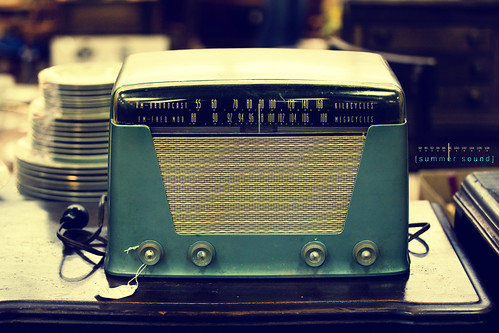Overview for Group Radio Show Projects
Each student will work in a group (comprised of 4-6 students) and create a radio show around a theme. Groups will be self-selected using the groups feature in Canvas (login to your course site and add yourself to a group by midnight on Sunday 9/23; if you do not add yourself to a group, it shall be done for you). Each radio show must be at least 5 min X the number of group members. In other words, a four person group must produce at least a 20 minute show. A six person group must produce a 30 minute show.
In addition, each student will have to produce a bumper (15-30 seconds) for their particular show and a commercial/promo (~60 seconds).
You may choose your theme from the following list:
- Autumn: Autumn is a time of change, as well as funny costumes, halloween experiences. Build a whole show around this season.
- Roadtrips: Everyone loves a roadtrip — the lure of the open road, the wind rushing through the windows, the smell of diesel on 95. Build a show around the magic and mystery of the road trip
- Amusement Parks: They’re amusing! They’re also a fascinating slice of American life. Build a show that explores the meaning of these places.
- Something Else: Don’t like these choices? Okay. Propose something else to Alan or Martha (ASAP), and we’ll let you know if it sounds good.
It may help to review the kinds of shows done in the past; see the archive of past radio shows. You may choose your format from the following types:
- Radio Drama: Write a fictional story around your theme and produce a radio drama, complete with sound effects, musical overtures, and funny voices.
- Interview Show: Either conduct a panel interview (with group members) or interview people from around campus/your neighborhood/your workplace about the theme. Warning: It is HARD to do entertaining and interesting interview shows. We’re not looking for boring people droning on about things. You’ll have to be creative to make an interview show interesting. They need some structure, and do not work as off the cuff banter. Use techniques demonstarted by shows like This American Life and/or Radiolab.
- Soundscape: Choose a variety of audio assignments from the audio section in the Assignment Repository, and produce them around your theme. Come up with an eclectic and interesting mix of audio pieces; make sure to build interludes between them. Work on producing a show that unifies these disparate pieces.
- Something Else: Don’t like these choices? Okay. Propose something else to Alan or Martha (ASAP), and we’ll let you know if it sounds good.
Whatever you do must have a structure similar to the ones we listened to- some sort of introduction, a mid show reminder, use of bumpers in the middle of a show, and an outro (or exit).
Deadlines
Sunday 9/23 (by midnight): Login to Canvas and assign yourself to a group. Come up with a name for your team. Tweet it out with the #ds106 hash tag
Sunday 9/30 (by midnight): As a group, settle on a theme and format for your show. One designated group member must write a blog post outlining these choices.
Sunday 10/7 (by midnight): Each student must write a blog post outlining his/her planned contributions to the radio show. In addition, each student must design a poster as an advertisement for their group’s show.
Friday 10/19 (by midnight): Radio shows and bumpers must be completed and uploaded to Dropbox at http://dropitto.me/ds106 (the password is “wejamecono”).
Saturday 10/20 and Sunday 10/21: Martha & Alan will be broadcasting shows live on ds106radio. At least one group member must be available by Skype to “call-in” to the radio station and discuss the show.
Sunday 10/21 (by midnight): Each group member should write a post on his/her blog reflecting upon the show and their contribution to it.
Note: As soon as groups are formed, you should begin working together to make decisions about your show. As soon as you know what you’ll be doing for your show, you should begin working on it! While we will be moving into other units for the next two weeks, we encourage you STRONGLY to not wait until the last minute to work on this project!
Group Communication
It is your responsibility, as a group, to determine the best way to manage group communications. You may use whatever tools you like. Here are a few suggestions:
- Canvas: Once your groups have been formed in Canvas, you will have access to a set of tools within that system. You can use these to share files, edit pages collaboratively, start discussion threads, or hold synchronous chat sessions. If you like, you can use these tools as your main avenue for communicating.
- Email: Once your groups have been formed, we will send out an email to each group so that you all have access to each other’s email addresses. You may use this to facilitate conversation.
- Twitter: You may wish to choose a hashtag for your group and ask everyone to use it whenever writing a tweet related to their work on the show.
- Google Hangout: If you’re looking for a tool for group meetings/conversations, Hangout is a good choice. You can each have audio/video as well as sharing screens. You can also record these sessions.
- Skype: Skype is always a good (free) choice for conducting group discussions. You can have an unlimited number of audio connections in a Skype call. In order to do group video calls, however, you have to have a Premium subscription (there is a free 7-day trial).
- TeamSpeak: ds106 has access to a TeamSpeak server which allows us to conduct group audio “calls” that can be recorded. In order to use it, every participant will need to download a (free) piece of software and then connect to our TeamSpeak server. If you want to use this service, contact Martha or Alan and we’ll send you directions.
- Your Blogs: While some blogging will be required as part of this project, we encourage you to go beyond those requirements. Use your blog as a place to narrate your show’s progress, communicate questions to your group, and ask for help!

cc licensed ( BY NC ) flickr photo shared by Brandon Christopher Warren
Grading
You will receive a group grade on your radio show, as well as an individual grade for your work in the show (based on your reflections on your blog). Generally, shows will be graded on the following criteria:
- Creativity: We’re looking for you to entertain us! Your show should creatively interpret your theme in a way that makes for an enjoyable (not boring) listening experience. It is NOT considered creative to pick a theme and then have every person simply turn on a mic on their computer and talk about it. Plan your show/segments. Think about what kind of audio techniques and storytelling techniques you can use to make it/them as entertaining as possible!
- Quality: We know that you’re not audio experts and that producing really good radio takes years of practice. However, we still expect a modicum of basic quality from your show. We should be able to understand what you are saying. There shouldn’t be a lot of background noise or static. Music and effects should be clear and well-modulated. The sound shouldn’t go in and out or have dramatic changes in volume.
- Groupwork: In order to produce a really solid show, you will need to work well together. The best shows involve regular communication and collaboration among members, particularly during the planning stages. The weakest shows tend to be ones where the groups pick a theme and then everyone goes off in different directions and they don’t really consult on how everything goes together.



Add a comment